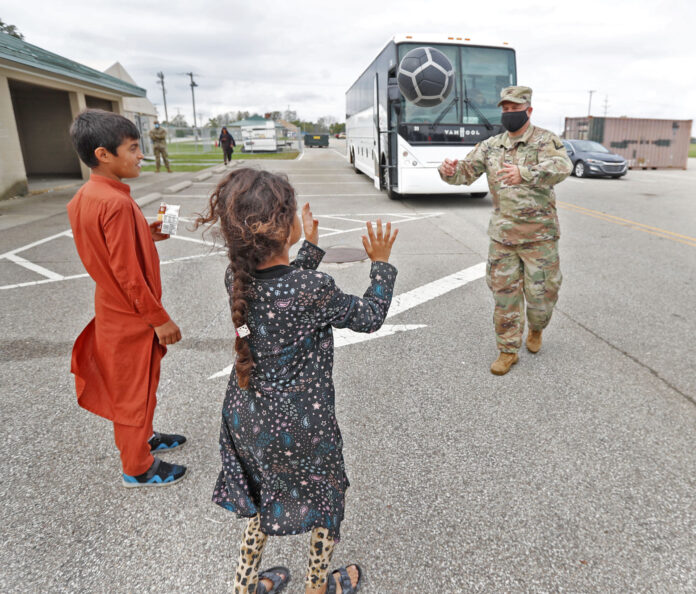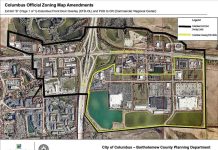By Leeann Doerflein | Daily Journal
For The Republic
CAMP ATTERBURY — They uprooted their entire lives.
Sulaman and Arzo Akbarzada were about to wed when the Taliban took over the city they lived in. Instead of saying “I do,” the couple started plotting how to get out of Afghanistan.
Because Arzo’s family has ties to the U.S. military, neither of them nor their families were safe to stay in their home country, Sulaman Akbarzada said.
Now living at Camp Atterbury and having made it through the initial resettlement process, they asked about getting married. With help from the U.S. Department of State, they wed last week at a chapel on the southern Johnson County base.
“I gave my word to her that when we go to America, we will get married. Thank you to all of you. You (helped) me keep my word,” Sulaman Akbarzada said.
Like others who have been on the base since the start of Operation Allies Welcome, the couple is now most of the way through the resettlement process, awaiting housing and a work permit. Soon, they will begin their new lives in America.
They hope to move to San Diego to live close to friends who are already in the United States, but would be happy anywhere they can lead a peaceful life. Both Sulaman and Arzo Akbarzada said they were grateful they made it out of Afghanistan safely and have a chance to start over.
“Anything can happen. I wish to go over there. If they can’t find a house for us there, they can put us anywhere. I will just be in peace — that’s all I want,” Sulaman Akbarzada.
They are just two of the 70,000 Afghan refugees who have entered the United States after fleeing Afghanistan for safety, due to their ties to the decades-long U.S. mission there. They are among about 6,700 who are being temporarily housed at Atterbury.
Operation Allies Welcome officials explained the process of intake and resettlement during a media tour Thursday, the media’s first opportunity to see first-hand what it’s like on the base. The mission involves multiple federal agencies, including the Departments of State, Homeland Security, Immigration and Customs, the FBI and intelligence agencies.
Throughout their journey to the United States, non-governmental organizations and translators have helped each group of refugees along the way, making sure their needs are met and they have a true understanding of the process.
The refugees landed at Indianapolis International Airport after a lengthy international journey, typically after several layovers in places such as Qatar and Germany, where they underwent initial background checks and were given COVID-19 tests.
They were taken by bus to Camp Atterbury from the airport. They are first taken to a warehouse where they check in and are given temperature checks, a rapid COVID-19 test, and food and water. Then they are given housing assignments, supplies such as toiletries, baby items, clothes and shoes, and receive a briefing on the next steps of the process.
The refugees are housed in five neighborhood units of about 850 to 900 people, with each barracks housing 40 to 150 people. Aside from beds and bathrooms, each neighborhood has a tent or building set up for prayers, and an area to get snacks and supplies.
Each barracks holds either males or females, and officials made efforts to house family units next to each other.
Each neighborhood has a “town council” that shares input on the needs and wants of their neighbors with Atterbury officials. That input has led to some changes and quality of life improvements at the base, including the formation of a food council. The council’s members helped create a halal menu of Afghan dishes that meet religious dietary needs and give the refugees a taste of home.
Once settled in their neighborhoods, the refugees start the resettlement process. During that process, they are connected to government agencies that help them secure work permits, find a place to live and get established in the country.
They also undergo medical screenings, get blood draws to test for communicable diseases. Vaccines for diseases such as mumps, measles, polio and COVID-19 are required to be allowed to leave the base, and flu vaccines are strongly recommended, officials said.
While they wait to be resettled elsewhere, refugees take English and cultural education classes. The children play sports or share donated toys to pass the time. Some refugees are fluent, while others have few English language skills. The cultural education classes teach refugees about life in America, from simple things such as how to cross the street, to information about states where they are hoping to relocate.
The refugees are also being connected to a wide range of services, such as mental health care to deal with the trauma of moving away from the only life they’ve ever known. Organizations are stepping in to help the refugees get resettled. For example, the Chase Bank branch in Franklin has helped refugees set up bank accounts in the United States.
The length of the resettlement process can vary widely depending on the circumstances, said Aaron Batt, the homeland security lead assigned to Camp Atterbury. If the refugee has family in the United States, they may leave in a matter of weeks. But if they don’t have family in the country, it could take several months, he said. There is no specific timeline to get all of the refugees resettled at this time.
While they wait in limbo for next steps, the refugees take time to reflect on their experiences and plan for their futures.
Afghans like Aziz Sadhe had their lives disrupted by the Taliban twice. When U.S. and NATO allies came to fight the War on Terror, there was hope for a brighter future, he said.
For years, the country got to experience freedoms they dreamed of under the Taliban, only to have those hopes slashed again when the Taliban regained control, he said.
Sadhe, who worked for the Afghan government, fled. He wanted to stay behind and help, but the U.S. Embassy in Kabul asked him to gather his family and get out for their safety, he said.
With no more than what could fit in a carry-on bag, Sadhe and his family boarded a plane, leaving behind their country that was once again under siege.
Afghans and the Afghan government officials alike were shocked the Taliban was able to take over so quickly. They had hoped their newfound democracy would stand the test of time, but that all vanished overnight, he said.
“We thought we were going to make it this time. … Democracy. We were going to have a constitution, women’s rights, human rights. Everything was in place. We were hoping the new generation — about 65% of the Afghan population is all under age 18 — would come in and build up with the help of the international community. … We lost that opportunity and we don’t know what is going to happen next,” Sadhe said.
They’re concerned the Taliban will take the country back in time, going back on their word to do things differently this time.
“They are coming back with the slogan that they are no longer the same Taliban that they were in the year 2000. They are saying they’ve learned from their mistakes and they won’t do the things they did at the time,” he said. “But it looks so far that there are very few changes. It looks pretty much the same.”





